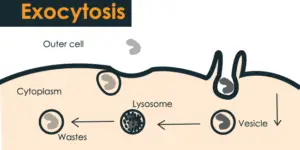
Exocytosis , Let’s Have An Overview On It
Exocytosis is a process that uses to move material from inside the cell to the exterior of the cell. This process needs energy and therefore is a type of active transport. It is the reverse process of endocytosis, in which substances move into the cell. It is a process that occurs in the cells of plants and animals.

Exocytosis is the most common secretion mechanism. It underlies various phenomena such as the external secretion of the protein, and hormones, the release of neurotransmitters when transmitting signals from one cell to another. From the Golgi apparatus, vesicles form to fuse with the plasma membrane.
The new process molecule then travels back into another vesicle to release from the Golgi apparatus to fuse with the endoplasmic membrane of the cell wall, where it will eventually release to the outside of the cell.
Types and steps of exocytosis
There are three main types which are as follows:
- Constitutive exocytosis is one that occurs in all cells. It involves the regular secretion of molecules. This is a necessary process for building the extracellular matrix and delivering proteins to the outer cell membrane. Secretory vesicles deliver to the surface of the cell and merge with the outer membrane.
- Regulated exocytosis depends on the presence of extracellular signals to displace materials in the vesicles. They release molecules that perform specific functions in the body or affect the physiology of other cells. They fail to merge with the plasma membrane. Some examples are neurons and granular cells.
- Lysosome mediated exocytosis contains acid hydrolase enzymes that destroy waste, germs, and cellular debris. Lysosomes transfer the elements that have been broken down onto the cell membrane, where they merge with the membrane and release the contents into the extracellular matrix.
Steps
Constructive exocytosis occurs in four steps while the regulatory exocytosis occurs in five steps. The steps are as follows,
- Vesicle trafficking: vesicles transfer to the cell membrane along the microtubules of the cytoskeleton. This step may require the movement of secreted material over a considerable distance, such as in a neuron. The movement of the vesicles is supported by the motor proteins kinesin, dynein, and myosin.
- Tethering: When the cell vesicles reach the plasma membrane, the vesicles attach and they eventually pull into contact with each other.
- Docking: This is the attachment of the vesicle membrane to a cell membrane. The phospholipid bilayers of the vesicle membrane and cell membrane start to meld.
- Priming: Priming occurs with unconstitutional exocytosis. There is a specific modification that must occur immediately in certain elements of the cell membrane for exocytosis to occur, which assist in signaling processes that provoke exocytosis.
- Fusion: Two types of fusion are complete fusion and temporary fusion. Upon complete fusion, the vesicle membrane completely fuses with the cell membrane. The energy comes from the ATP which also required for the separation and fusion of lipid membranes after the cell content has been released.
While In the case of temporary fusion, the vesicle temporarily fuses with the cell membrane in order to release its contents into the exterior of the cell. Then the vesicle detaches from the cell membrane and reforms before returning into the cell.
Examples
Some of example are:
- The secretion of the protein
- Exocytosis in the Pancreas
- Exocytosis in Neurons
Now compare with other terms.
Exocytosis and endocytosis
Endocytosis is the transport of particles and substances inside the cell, while the exocytosis is intracellular transporting material outward. In both cases, the molecules transport wrap in vesicles out of the plasma membrane of the cell, in the case of exocytosis, or into the cell in the case of endocytosis.